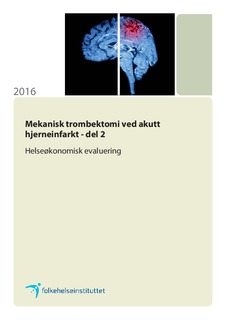Mekanisk trombektomi ved akutt hjerneinfarkt del 2. Helseøkonomisk evaluering
Abstract
Background
The Knowledge Centre at the Norwegian Institute of Public Health has received a commission from Regional Health Authorities to perform a health technology assessment (HTA) of mechanical thrombectomy compared with standard treatment for acute stroke. First part of the HTA was published in May 2016 and included effect and safety, calculation of the costs associated with the procedure, and organisational and ethical aspects of introducing of thrombectomy as a routine treatment in the Norwegian hospitals. According to the report, thrombectomy is an effective and safe treatment for patients with stroke with occlusion in large blood vessels. Measures to implement Thrombectomy as a routine treatment will require financial expenditures. It is therefore necessary to investigate if the additional costs are reasonable in relation to the incremental health effects.
Objective
Our objective was to assess cost-effectiveness of mechanical thrombectomy as additional treatment to standard therapy (thrombolysis) compared with standard treatment alone in the Norwegian settings, as well as to perform a budget impact analysis.
Method
We performed a cost-utility analysis (CUA) where relevant costs were expressed in Norwegian kroner (NOK) and effects were expressed in quality-adjusted life-years (QALYs). The analysis was carried out in a healthcare perspective. A decision analytic model of the Markov type, in which a cohort of patients is followed over a given period of time, was developed in TreeAge Pro® 2016. The results were expressed as mean incremental cost-effectiveness ratio (ICER). Uncertainties in model parameters were handled by performing one way (Tornado diagram) and probabilistic sensitivity analyses, designed as a Monte Carlo simulation, with 10 000 iterations. Additionally, a scenario analysis was performed, where increased costs of investment in establishing of two new centres for treatment with thrombectomy were assumed, along with the assumption about all eligible patients treated within 5 hours from symptom onset. We have also performed a budget impact analysis of implementation of thrombectomy as a routine treatment based on the cost results of the cost-utility analysis.
Results
The results of our base case analysis indicate that:
• Treatment with thrombectomy was associated with more quality-adjusted life-years (QALYs)
• Treatment with thrombectomy was somewhat more costly than standard treatment in lifetime perspective
• The incremental cost per QALY gained of thrombectomy over a 25 year period was 12,034 kroner per QALY gained
In the scenario analysis we assumed investment costs of 10 million kroner for establishing two new centres for treatment with thrombectomy, as well as improved time to treatment (up to five hours from symptom onset). We have found that:
• Treatment with thrombectomy was associated with more quality-adjusted life-years (QALYs)
• Treatment with thrombectomy was more costly than standard treatment in lifetime perspective
• The incremental cost per QALY gained of thrombectomy over a 25 year period was 77,233 kroner per QALY gained
Results of our sensitivity analysis indicate that cost parameters had the greatest impact on the results. Nowadays, about 150 patients in Norway receive treatment with thrombectomy annually. Results of the budget impact analysis show that increasing the number of patients treated with thrombectomy to 450, would be associated with an incremental costs of about 18 million kroner with the assumption of sufficiency of the existing capacity.
Discussion
Cost data had the greatest impact on the results. At the same time we lack good cost estimates for Norway, particularly for long-term costs associated with further treatment, care and rehabilitation for patients after stroke with different grades of disability.
Conclusion
Our cost-utility analysis indicates that mechanical thrombectomy as additional treatment for patients with ischaemic stroke with occlusion of the big blood vessels, is cost-effective compared with standard treatment alone.
________________________________________
• DELRAPPORT 1
o Mechanical thrombectomy for acute ischemic stroke
